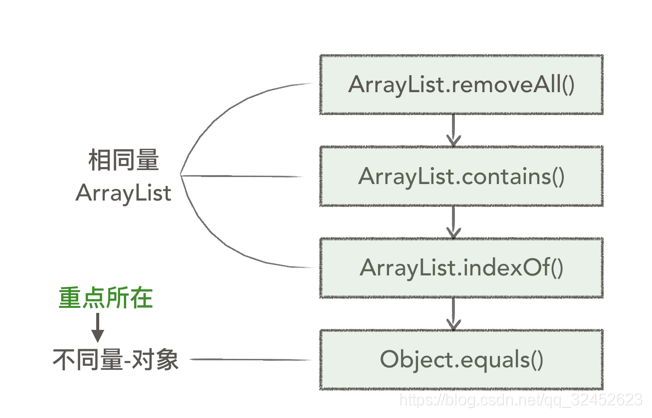前言:
本来以为是个错误使用的问题,稍微那么深究一下,发现脑海中,关于这个部分的知识库存已经告急了,可不能啊。
removeAll() 失效重现
今天做一个批量删除的功能,我使用了 List.removeAll()这个方法,但是该代码执行前后,被操作的列表的 size 并没由发生改变。
排查了一下,是因为两个列表中存储对象不同的原因。
为了更加清楚的理解,我写了简单的小例子,复现了错误的场景:
实体类:
public class Bean {
private int id;
private String name;
private String address;
public Bean(int id, String name, String address) {
this.id = id;
this.name = name;
this.address = address;
}
}
构建场景:
ArrayList<Bean> allStudents = new ArrayList<>();
ArrayList<Bean> boyStudents = new ArrayList<>();
for (int i = 0; i < 10 ; i++) {
Bean bean = new Bean(i,"name is "+i,"address is "+i);
allStudents.add(bean);
}
for (int i = 0; i < 5 ; i++) {
Bean bean = new Bean(i,"name is "+i,"address is "+i);
boyStudents.add(bean);
}
System.out.println("allStudents.size()------before-------------->"+allStudents.size());
System.out.println("remove result : "+allStudents.removeAll(boyStudents));
System.out.println("allStudents.size()-------after-------------->"+allStudents.size());
输出结果是:
allStudents.size()------before-------------->10
remove result : false
allStudents.size()-------after-------------->10
但是,换 String 对象执行 removeAll() 竟然可以成功!
因为操作对象不同,这是一个很简单的原因,但是接下来要实验的另一个小例子,绝对让你非常吃惊,我们讲Bean 替换成 String 字符串试一下。
ArrayList<String> allStudents = new ArrayList<>();
ArrayList<String> boyStudents = new ArrayList<>();
for (int i = 0; i < 10 ; i++) {
String bean = "name is "+i+"address is "+i;
allStudents.add(bean);
}
for (int i = 0; i < 5 ; i++) {
String bean = "name is "+i+"address is "+i;
boyStudents.add(bean);
}
System.out.println("allStudents.size()------before-------------->"+allStudents.size());
System.out.println("remove result : "+allStudents.removeAll(boyStudents));
System.out.println("allStudents.size()-------after-------------->"+allStudents.size());
输出结果是 :
allStudents.size()------before-------------->10
remove result : true
allStudents.size()-------after-------------->5
揭开这一切的面纱
从打印结果很明白的看到,removeAll() 成功执行。String也是对象,为什么会这样?代码不会说谎,我们去源码中去寻找答案。
从源码中发现,ArrayList 执行 removeAll() 方法流程如下图所示:

通过控制变量法分析,很容易就聚焦到 equals()这个方法,这个方法是 Object 的方法,默认实现是比较对象在内存的地址。
public boolean equals(Object obj) {
return (this == obj);
}
再看一下 String 中 equals() 方法,重写了 Object 的这个方法,不再是比较地址,而是比较字符串是否相同。
public boolean equals(Object anObject) {
if (this == anObject) {
return true;
}
if (anObject instanceof String) {
String anotherString = (String) anObject;
int n = count;
if (n == anotherString.count) {
int i = 0;
while (n-- != 0) {
if (charAt(i) != anotherString.charAt(i))
return false;
i++;
}
return true;
}
}
return false;
}
这样的话,引发了一个思考,也就是说,如果自定义对象,重写 equals() 中的实现,也是可以实现非相同对象的情况下,成功 removeAll()的。这里我用 上面例子的 Bean 实体类简单实验一下:
public class Bean {
private int id;
private String name;
private String address;
public Bean(int id, String name, String address) {
this.id = id;
this.name = name;
this.address = address;
}
@Override
public boolean equals(Object o) {
if (this == o) return true;
if (o == null || getClass() != o.getClass()) return false;
Bean bean = (Bean) o;
if (id != bean.id) return false;
if (!name.equals(bean.name)) return false;
return address.equals(bean.address);
}
@Override
public int hashCode() {
int result = id;
result = 31 * result + name.hashCode();
result = 31 * result + address.hashCode();
return result;
}
}
再次执行第一个例子的程序,ArrayList 成功 removeAll,打印信息如下:
allStudents.size()------before-------------->10
remove result : true
allStudents.size()-------after-------------->5
重写 equals() 方法一定要符合规范!
但是这里我们要特别注意的是,当我们重写 equals() 方法的时候,一定要遵守它的规范,否则在程序使用中,使用错误实现 equals() 的类时可能出现无法预料的问题,而且很有可能,找了很久都定位不到问题在哪!,想想都后背发冷。
以下是 Object 中 equals()的方法说明注释,绝对原汁原味!但是我相信肯定有人看了一遍还是不知道说的啥,非常正常,我看两遍也是,英语渣没办法,只能花更多时间去理解它,因为真的真重要。
/**
* Indicates whether some other object is "equal to" this one.
* <p>
* The {@code equals} method implements an equivalence relation
* on non-null object references:
* <ul>
* <li>It is <i>reflexive</i>: for any non-null reference value
* {@code x}, {@code x.equals(x)} should return
* {@code true}.
* <li>It is <i>symmetric</i>: for any non-null reference values
* {@code x} and {@code y}, {@code x.equals(y)}
* should return {@code true} if and only if
* {@code y.equals(x)} returns {@code true}.
* <li>It is <i>transitive</i>: for any non-null reference values
* {@code x}, {@code y}, and {@code z}, if
* {@code x.equals(y)} returns {@code true} and
* {@code y.equals(z)} returns {@code true}, then
* {@code x.equals(z)} should return {@code true}.
* <li>It is <i>consistent</i>: for any non-null reference values
* {@code x} and {@code y}, multiple invocations of
* {@code x.equals(y)} consistently return {@code true}
* or consistently return {@code false}, provided no
* information used in {@code equals} comparisons on the
* objects is modified.
* <li>For any non-null reference value {@code x},
* {@code x.equals(null)} should return {@code false}.
* </ul>
* <p>
* The {@code equals} method for class {@code Object} implements
* the most discriminating possible equivalence relation on objects;
* that is, for any non-null reference values {@code x} and
* {@code y}, this method returns {@code true} if and only
* if {@code x} and {@code y} refer to the same object
* ({@code x == y} has the value {@code true}).
* <p>
* Note that it is generally necessary to override the {@code hashCode}
* method whenever this method is overridden, so as to maintain the
* general contract for the {@code hashCode} method, which states
* that equal objects must have equal hash codes.
*
* @param obj the reference object with which to compare.
* @return {@code true} if this object is the same as the obj
* argument; {@code false} otherwise.
* @see #hashCode()
* @see java.util.HashMap
*/
public boolean equals(Object obj) {
return (this == obj);
}
equals 方法实现的时候必须要满足的特性:
1.(reflexive)自反性:
对于任何非 null 的引用值 x,x.equals(x) 必须为 true;
2.(symmetric)对称性:
对于任何非 null 的引用值 x,y,当且仅当 y.equals(x) 返回 true 时,x.equals(y) 也要返回 true 。
3.(transitive)传递性:
对于任何非 null 的引用值 x,y,z, 如果 x.equals(y) 返回 true,y.equals(z) 返回 true,那么 x.equals(z) 一定要返回 true。
4.(consistent)一致性:
对于任何非 null 的引用值 x,y,只要 equals() 方法没有修改的前提下,多次调用 x.equals(y) 的返回结果一定是相同的。
5.(non-nullity)非空性
对于任何非 null 的引用值 x,x.equals(null) 必须返回 false。
这些特性约束我们重写 equals()的时候,写条件判断一定要谨慎,下面是提供的一个模版:
@Override
public boolean equals(Object o) {
if (this == o) return true;
if (o == null || getClass() != o.getClass()) return false;
(MyClass) myclass = (MyClass) o;
if (this.xx != bean.myclass.xx) return false;
return myclass.equals(myclass.xx);
}
重要!覆盖 equals 时,一定要同时覆盖 hashCode
这样做的目的是保证每一个 equals()返回 true 的两个对像,要有两个相同的 hashCode 。
在上面演示的例子中,不覆盖 hashCode ,equals 方法表现的也很好,调用 List.removeAll 也能成功执行。看似是没有什么问题,但是当我们试图使用 hashMap 做存取操作的时候,就会出现问题。
HashMap<Bean,String> allStudents = new HashMap<>();
for (int i = 0; i < 10 ; i++) {
Bean bean = new Bean(i,"name is "+i,"address is "+i);
allStudents.put(bean,"i :"+i);
}
Bean bean = new Bean(1,"name is 1","address is 1");
System.out.println(" allStudents.get(bean)----------------------->"+ allStudents.get(bean));
输出结果:
Bean 中不正确覆盖 hashCode(),取不到值:
allStudents.get(bean)----------------------->null
Bean 中正确覆盖 hashCode(),能取到值:
allStudents.get(bean)----------------------->i :1
原因在于,HashMap 执行 get() 操作的时候是通过散列码,也就是对象的 HashCode 来搜索数据的。所以,当不重写 hashCode() 方法或者重写的不规范的时候,就会出现这样的问题。
使用散列码判断对象的,有 HashMap ,HashSet,HashTable 等,因此,覆盖 equals() 时,一定要同时覆盖 hashCode()。
快速生成euqals() and hashCode()!
看到上面的解释,估计大家都感觉覆盖这俩方法的时候都有点害怕了,但是告诉大家一个好消息,Android Studio 有这两个方法的快速生成模版,使用方法是 右键->generate->euqals() and hashCode(),也可以直接使用快捷键 command+N ->euqals() and hashCode()。

最后
到这里,我想到,一个在面试的时候,经常被问到的 java 基础题:
java 中 == 和 equals 和 hashCode 的区别?
我想现在,如果再被问到这个问题,我肯定可以比之前回答的要好一点了。
java 中有两种类型,值类型和引用类型。其中,== 值类型和引用类型都可以运算,equals 和 hashCode 是引用类型特有的方法。
对于值类型,== 比较的是它们的值,对于引用类型,== 比较的是两者在内存中的物理地址。
equals() 是 Object 类中的方法,默认实现是使用 == 比较两个对象的地址,但是在一些子类,例如 String,Float,Integer 等,它们对 equals进行覆盖重写,就不再是比较两个对象的地址了。
hashCode() 也是 Object 类的一个方法。返回一个离散的 int 型整数。在集合类操作中使用,为了提高查询速度。
当覆盖 equals() 的时候,一定要同时覆盖 hashCode(),保证 x.equals(y) 返回为 true 的时候,x,y 要有相同的 HashCode 。
回答完毕。
参考资料
Effective Java 中文版第二版






















 1万+
1万+











 被折叠的 条评论
为什么被折叠?
被折叠的 条评论
为什么被折叠?








